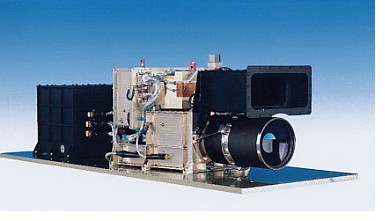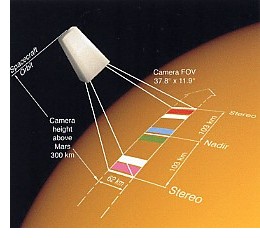|
HRSC: High/Super Resolution Stereo Imager
for the Mars Express Mission

Mars
Express is the name of the 2003 ESA mission to Mars. It consists of an
orbiter and a small lander, Beagle-2. One of the primary instruments on
the orbiter will be the High/Super Resolution Stereo Imager (HRSC).
Science objectives of HRSC
The scientific objectives of the HRSC as formulated by 36 scientists from
7 different countries are:
-
characterization of the surface structure and morphology at high resolution
-
characterization of the surface topography at high spatial and vertical
resolution
-
investigation of the geologic evolution of the Martian surface and
determination of the sequence of events
-
terrain classification at high spatial resolution by means of colour imaging
-
acquisition of data of the structure of the Martian crust and the elastic
response of the lithosphere
-
refinement of the geodetic control network and the Martian cartographic
basis
-
characterization of the evolution of volcanism and its influence on the
Martian environment
-
information on the past climate, its variability and the role of water
through Martian history
-
analysis of surface-atmosphere interactions (variable features, frosts)
and eolian processes and phenomena
-
analysis of atmospheric phenomena (dust devils, cloud topography, aerosol
content)
-
characterization of past, present, and future landing sites and support
for lander experiments
- support for exobiological studies
- observation of Phobos and Deimos
![[Top]](/images/icons/top.gif)
HRSC instrument description
The HRSC will take images of the surface and atmosphere of Mars in
full colour, 3D and at high resolution. Its greatest strength,
however, is its unprecedented pointing accuracy, which it achieves by
combining images at two different resolutions. This makes it
particularly useful for, among other things, assessing potential
landing sites for future missions to Mars. The camera, which weighs
21.2 kg will take 3D colour pictures of the Martian surface and of
atmospheric phenomena, such as cloud cover and dust storms, at a
resolution of 10-30 m. At the same time, a super resolution channel
will allow it to home in on selected sites of particular interest for
imaging down to 2 m/pixel resolution. Although cameras on other
spacecraft have imaged small areas at high resolution, or large areas
at low resolution, they have never before combined the two and hence
have been unable to determine the location of high resolution images
to better than a few kilometres. The HRSC's images will be in 3D and
full colour. The 3D imaging will provide a measurement of the height
of features within an image relative to each other. The vertical
resolution will be similar to the horizontal resolution.

The camera has ten channels, each consisting of a CCD (charge coupled
device). One will be the super resolution channel and the other nine
will record the same image almost simultaneously at the lower
resolution. Four of these channels will record the image at different
wavelengths (colours), and five will view it from different angles to
provide the 3D effect. When the camera is 300 km above the
surface, its footprint will be 62 km by 206 km. The diagram to the
right shows the CCD lines except for the super resolution channel. The
five white lines are used to provide the stereo effect.
![[Top]](/images/icons/top.gif)
MPS involvement
MPS has no hardware participation in HRSC. We have have however, the leading
role within the HRSC team, in the Martian atmospheric science to be done
with this instrument. Some of the topics which interest us are:
-
synaptic observations of the Martian atmosphere and its diurnal and seasonal
variations
- dust devils and storms
- atmospheric aerosols including dust and ice particles
- clouds and fogs
- seasonal variations of the polar cap region
- so-called surface variable features
![[Top]](/images/icons/top.gif)
Related links
 Institute of Space Sensor Technology and Planetary Exploration
at the DLR, in Berlin
Institute of Space Sensor Technology and Planetary Exploration
at the DLR, in Berlin
|
